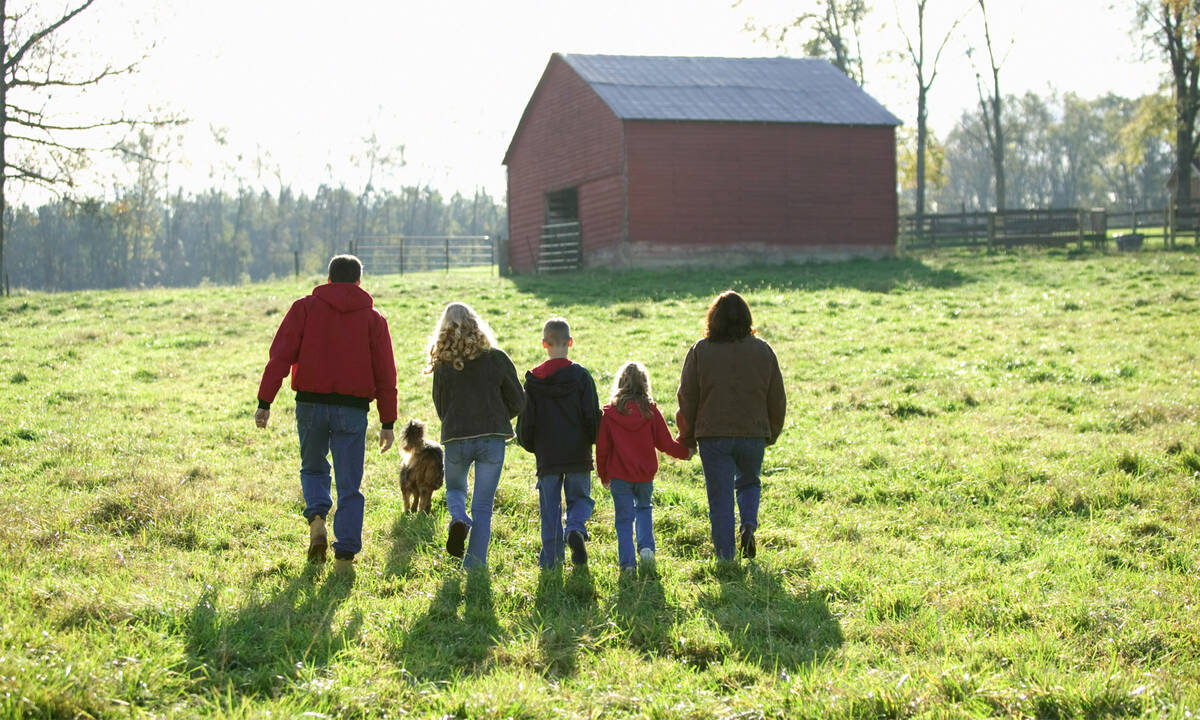Everyone knows that the number of farms and farmers in Canada is declining. It’s a well-documented, ongoing trend. What few of us realize, however, is that it isn’t small farms that are disappearing the fastest.
It’s our mid-size farms that are dying.
The numbers from Statistics Canada are bleak. Between 1980 and 2005, Canada lost 28 per cent of its farms. But that loss wasn’t consistent. It varied tremendously by farm size, and the heaviest losses of all were experienced by farms that had $100,000 to $250,000 gross revenue, which dropped 45 per cent.
Read Also

Tips for how to be fair to all siblings during farm succession
family walking through a field
While it’s bad enough that over those 25 years we lost more than a quarter of the farm operations in Canada, many would argue that it’s even worse when we discover nearly half of the mid size, commercial farm operations in Canada disappeared. After all, mid-size farms are often considered the lifeblood of rural society.
Why are mid-size farms disappearing?
There are two totally different theories to explain why mid-size farms are disappearing.
The first is that economies of scale are driving us toward an agriculture that has fewer but larger farms. It’s a popular view, especially among government policy makers who point out that it’s easier for today’s farmers to size up, both in livestock and in crops. For example, Andrew Goldstein, director-general of research and analysis with Statistics Canada, says changes in technology, including bigger equipment, plus the availability of capital are the main reasons why the average size of farms is increasing.
James McDonald, chief of the USDA’s agricultural structure branch, agrees but is even more direct. “Production is shifting to larger farmers because the financial nature of large farms is better,” McDonald says. “Technology is very significant… a farmer simply can farm more acres now.”
In the second camp are people like Chuck Hassebrook, who say government, not economics, is the cause. “Public policy reinforces concentration in agriculture,” says Hassebrook, executive director of the Center for Rural Affairs in Nebraska. “The bigger you get, the more you get from the government, and this is squeezing the mid-size farmer out.”
Yes, technology might enable the upsizing of agriculture, but technology is itself a product of public policy, Hassebrook argues. “Government investment in agricultural research is focused on new technology and the use of capital to replace farm labour.”
For an example, look at hog production, Hassebrook says. “It has been proven that free-range hog production is almost as efficient as hogs raised in total confinement. However, public research dollars only go to total-confinement systems.”
John Peck, executive director of Wisconsin-based Family Farm Defenders, provides another example: “The most efficient dairy operation is a herd size of less than 100 free-ranging cows fed a grass-based diet, yet dairy farmers are pushed to invest in total confinement systems on small land bases that require purchase of feed.”
Peck admits there are a combination of factors which result in fewer, larger farmers but he feels public policy is the primary reason the mid-size farm is suffering. “The trend to large farms is not natural evolution,” Peck says. “It is consensus policy. The Farm Bill funnels taxpayer subsidies to large farm operations”
In 2006, the USDA reported on the shift of subsidies to larger farms. In 1989, the average recipient of U.S. commodity payments earned $46,000. Half the payments went to farms with higher household incomes. Half went to farms earning less. Basically a quarter of payments went to farms with $95,000 in household income, and only 10 per cent went to farmers earning over $190,000. (Note: the USDA adjusted these to 2003 dollars.)
Since then, payments have shifted sharply to higher-income farm households, the report says. By 2003, the average recipient had a household income of $76,000. A quarter of subsidies went to households earning more than $160,142, and 10 per cent went to households earning more than $342,918.
At the same time, multinational agribusinesses also favour large farms over mid-size ones, says Peck. “There is no free market in food production. An oligopoly of a few large corporations controls both the inputs farmers need and the markets for farmers’ production.”
Big companies target big farmers and give them price breaks and other incentives. The multinationals often also control delivery and transportion hubs as well as processing plants, meaning they can offer even more benefits to large farmers, Peck says.
Peck is also concerned about escalating land prices. Land is now priced well beyond its agricultural productive value, making it very difficult for young people to get started in the industry. He notes land prices are no longer being driven just by established farmers seeking to expand to capture economics of scale but also by speculators and foreign investors. He notes six per cent of the farmland in California is now owned by foreigners. It is the mid size farms which are being targeted for purchase and typically it is large established farmers who are the new owner’s first choice to farm the land.
Meanwhile in Canada
Statistics Canada’s Goldstein responds that most program payments in Canada are now based on margin rather than production, so he believes public policy is having less impact on the shift in farm size in Canada. However, acreage and production based programs in this country remain, including recent ad hoc federal payouts to address extreme weather, and they may be advantageous to large producers.
And even the margin-based programs can end up helping large farmers more than small farmers, despite the fact they aren’t intended to do that. Governments may assume that Canadian farms participate in government programs regardless of size, but this simply isn’t true.
Small and mid-size operations are less likely to qualify or participate in programs. The federal government’s Financial Situation and Performance of Canadian Farms 2009 publication states it bluntly: “Business-focused farms with $100,000 or more in gross revenues and non-family farms are more likely to participate in agricultural programs.”
Ray Bollman of the rural research group at Statistics Canada says the midsize farm is under the greatest economic pressure. “The total income of the farmer and the total income of the farming family is higher for farmers/families with smaller agricultural holdings and is higher for farmers/families with larger agricultural holdings,” Bollman says. “Income is lower for farmers/families with mid-size agricultural holdings.”
“On mid-size holdings, there is no time for off-farm work and the farm is not big enough to generate the big bucks,” Bollman explains.
Another economic factor which must also be considered in the disappearance of mid-size farms is the lack of access to markets for mid-size farm operations. There are tax implications which favour large farm operations and non-farmer investors in farm operations. As well, mid-size farms tend to have less access to credit.
The solution
In most producer’s minds, there is only one solution to the mid-size farm crisis. The farms must get bigger.
They must purchase the newest technology, be more productive, and earn the economies of scale that empower large farm operations. Corporate agribusiness has done a great job of selling this dream to farmers. Bigger equipment, better pesticides, higher-yielding seed, and new technology all promise that farmers will get better returns when they invest in the goods and services these companies are selling.
The problem with this strategy is farmers who adopt agribusiness’s growth strategy are compelled to produce more just to generate returns to pay for their investment in the new products and technology. Yet this increased production only results in better prices while commodity prices are stable. But as increasing numbers of farmers strive to produce more in the name of efficiency, commodity prices are pressured downward. The result is an endless treadmill of rising costs and falling prices.
This trend is clearly evident in StatsCan figures which show gross revenue between 1990 and 2006 increased by 4.9 per cent per year while operating expenses increased by 5.5 per cent per year in this period. As a result, margins have decreased from 17.1 to 12.6 per cent.
There are two other factors which complicate the strategy of achieving profitability through growth. First, as costs increase on North American farms, we become less competitive in global markets. For example, in Brazil and Argentina, production costs of most crops and livestock are significantly lower than in Canada and the U.S. Second, the ramping up of agriculture production in Eastern Europe and developing countries will increase competition and further reduce commodity prices and our competitiveness. As farmers, we are rapidly pricing ourselves out of markets with our high-cost growth strategy.
The alternative strategy, which is widely promoted by policy makers, calls for diversification and niche marketing. “Large farms are not the only profitable farms,” says Goldstein. “Farms that identify and serve niche markets and that market directly to consumers can be very profitable.”
“It is very difficult for small operations to make a living producing a commodity,” agrees the USDA’s McDonald. “These operations need to differentiate their product. This may be done by strategies like finding a niche market, selling an organic product, or by specialization.”
McDonald says mid-size farmers need to take a close look at how many hours they are actually devoting to production of a commodity and what the real returns are per hour. He feels many producers are spending a lot of time for little return. For farmers in this situation, he suggests downsizing the operation to a lifestyle, retirement, or residential farm and seeking off-farm employment may be a better choice than trying to intensify or grow a mid-size farm operation.
Rural development specialists agree niche marketing can be a strategy in saving the mid-size farm, but this is not the only solution. James Richardson, economist at Texas A&M says mid-size farmers can gain economic power by working together. According to Richardson, by bulk purchasing their inputs and by marketing their production co-operatively, mid-size growers can get the same purchasing and marketing deals as a very large producer.
“Equipment sharing is another way mid size growers can realize cost savings,” says Richardson. “Geographic diversification is another option. Mid-size farmers in two different geographic areas may be able to share one line of equipment given the difference in timing of cropping operations.”
The disappearance of the mid-size farm is not new. The only difference today is the continually increasing size category that the mid-size farm fits into. Nor will we likely see the trend to larger farming operation slow or stop especially since this trend is unofficially endorsed by most governments and totally supported by agri-business.
Rather than discussing the economic survival of the mid-size farm, perhaps we should be asking if the mid-size farm should even be saved. After all, the disappearance of the mid-size farm is as much (or perhaps more) an issue of rural society as it is economics.
Do mid-size farm contribute more to local economies than large farms?CG















